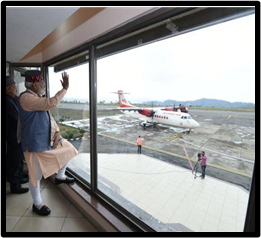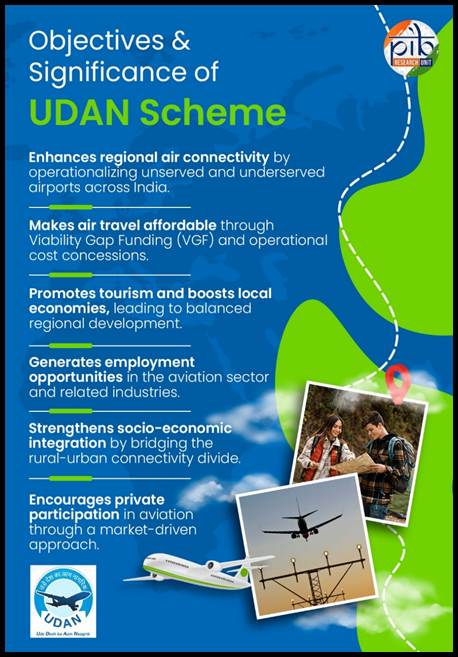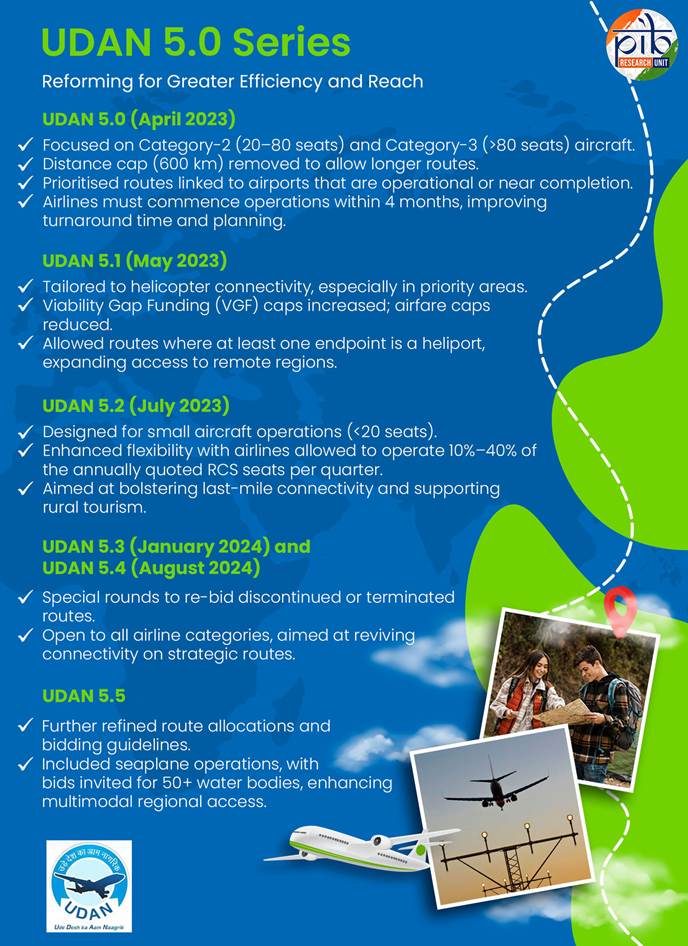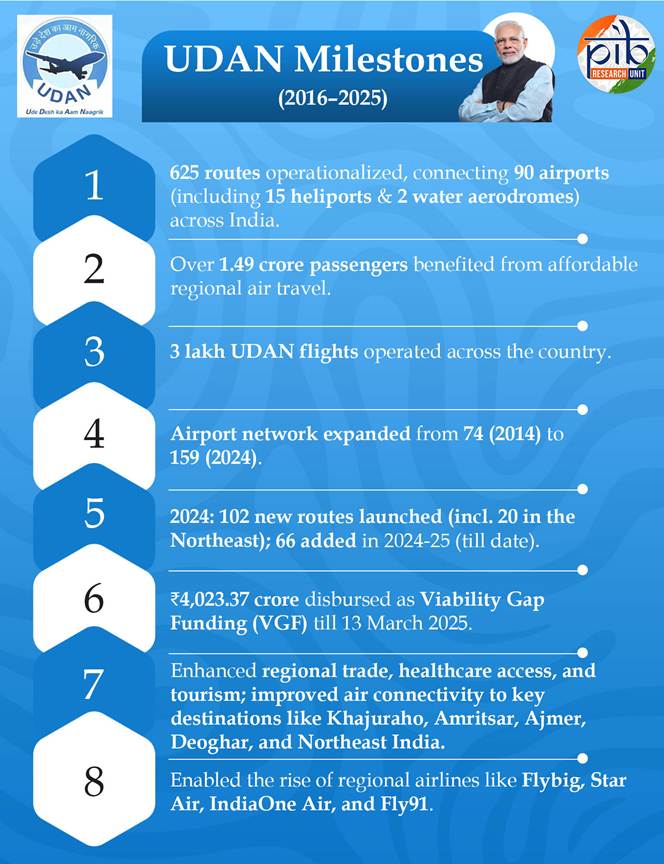UDAN Scheme
Connecting India, One Flight at a Time
“Aviation was once considered the domain of a select few, but that has changed now with the advent of UDAN. My dream is to see a person who wears a 'hawai chappal' to fly on the 'hawai jahaz’.”
- Prime Minister, Shri Narendra Modi |
Summary
|
Introduction
The sky, long seen as a symbol of aspiration, was once an unattainable dream for many in India. To bridge this gap, the Government of India, under the leadership of Prime Minister Shri Narendra Modi, launched the Regional Connectivity Scheme (RCS) – UDAN (“Ude Desh ka Aam Nagrik”) on October 21, 2016. Rooted in the Prime Minister’s vision that even a common man in slippers should be able to afford air travel, UDAN aims to democratize aviation by making flying accessible and affordable for all. Implemented by the Ministry of Civil Aviation, this flagship scheme has since transformed India’s regional connectivity landscape.
The dream of affordable air travel for the common citizen began to take tangible form with the first UDAN flight. This landmark flight took off on April 27, 2017, connecting the serene hills of Shimla to the bustling metropolis of Delhi. On April 27, 2025, this landmark event, which marked the beginning of a transformative journey in Indian aviation, opening up the skies to countless citizens, will complete 8 years.

The UDAN scheme was conceptualised under the National Civil Aviation Policy (NCAP) 2016, with a 10-year vision, to connect Tier-2 and Tier-3 cities through a market-driven yet financially supported model. The scheme incentivised airlines through concessions and Viability Gap Funding (VGF) to operate on regional routes, ensuring affordable fares and improved accessibility.

Components of UDAN Scheme
- Viability Gap Funding (VGF): Financial support to airlines to ensure affordable fares.
- Airfare Cap to ensure affordability.
- Collaborative Governance between Centre, States, Airport Authority of India (AAI), and private airport operators.
- Stakeholder Incentives:
The government has implemented several supportive measures to attract airlines to operate flights in less lucrative markets:
Airport Operators: They waive landing and parking charges for RCS flights, and the Airports Authority of India (AAI) does not levy Terminal Navigation Landing Charges (TNLC) on these flights. Moreover, a discounted Route Navigation and Facilitation Charge (RNFC) is applied.
Central Government: For the first three years, excise duty on Aviation Turbine Fuel (ATF) purchased at RCS airports is capped at 2%. Airlines are also encouraged to enter code-sharing agreements to expand their reach.
State Governments: States have committed to reducing VAT on ATF to 1% or less for ten years and providing essential services such as security, fire services, and utility services at reduced rates.
This collaborative framework has fostered an environment where airlines can thrive while serving regions that have long been overlooked.
Evolution of the UDAN Scheme: From Inception to Expansion
Since its launch in 2016, the UDAN scheme has evolved through multiple rounds, each expanding India's regional air connectivity scope and scale. Below is a summary of the key phases:
UDAN 1.0 (2017)
|
UDAN 2.0 (2018)
|
UDAN 3.0 (2019)
|
UDAN 4.0 (2020)
|

As UDAN entered its 9th year in October 2025, the scheme has achieved significant milestones

Key Innovations and the Road Ahead for Regional Connectivity
UDAN Yatri Cafes: In line with the vision of making air travel more inclusive, affordable Yatri Cafes have been launched at Kolkata and Chennai airports, offering quality food at accessible prices—tea for ₹10 and samosas for ₹20.
|
Seaplane Operations: To boost regional and last-mile connectivity, guidelines for seaplane operations were released on August 22, 2024, focusing on safety, security, and operational viability. UDAN Round 5.5 has been launched to invite bids from over 50 identified water bodies across the country.
|
Revamped UDAN Initiative: Building on the success of the original scheme, a revamped version aims to add 120 new destinations and enable affordable air travel for 4 crore more passengers over the next decade. The focus will be on expanding connectivity to remote, hilly, and aspirational districts, especially in the North Eastern region, with special support for helipads and smaller airports. |
Krishi UDAN Scheme: Designed to support farmers and improve value realisation for agri-produce, Krishi UDAN facilitates timely and cost-effective air logistics, particularly from Northeast, hilly, and tribal regions. This multi-ministry convergence scheme currently covers 58 airports, with a focus on 25 priority airports and 33 others nationwide.
|
Airport Infrastructure Development: The government has committed to developing 50 new airports over the next 5 years. This includes new greenfield airports in Bihar, expansion of Patna Airport, and development of a brownfield airport at Bihta, aiming to meet the future demand for air travel and regional growth.
|
Conclusion
UDAN is more than a policy—it's a transformative movement that has redefined the aviation narrative in India. By bridging the skies between Bharat and India, the scheme has made the dream of affordable air travel a reality for millions. It has not only brought remote regions onto the national aviation map but has also spurred local economies, boosted tourism, and generated employment across the country. As India marches towards becoming a global aviation hub, UDAN stands tall as a symbol of inclusive growth, resilience, and visionary governance, carrying the aspirations of a new India, one flight at a time.



addComments
Post a Comment